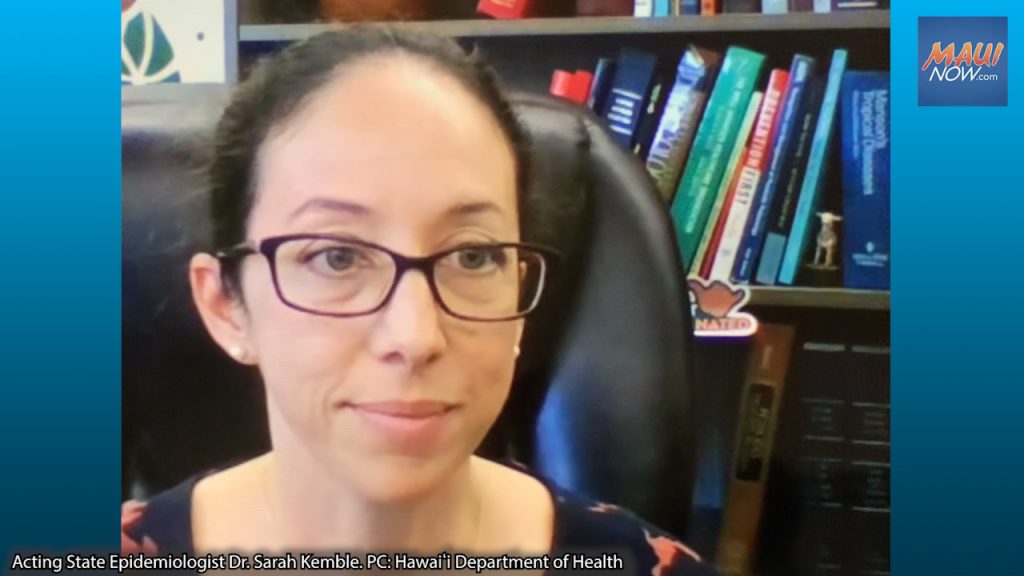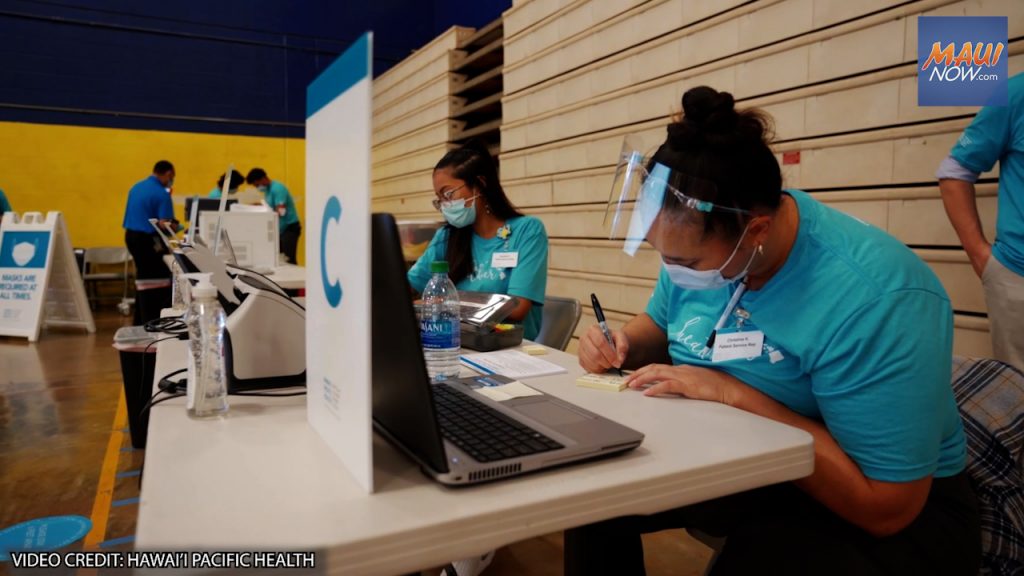Updated Health Guidance for Hawai‘i Public Schools Prioritizes In-Person Learning

The Department of Health this afternoon discussed updated school guidance on COVID-19.
Acting State Epidemiologist Dr. Sarah Kemble shared information during a press briefing on Monday saying, “This update to the guidance comes at a time when we are really emphasizing the prioritization of a return to in-person learning for students in K-12 schools.”
She continued: “This top priority comes out of recognizing the health impacts to children of not participating in in-person learning, and acknowledging that the science that has developed around effective mitigation strategies in schools during the COVID-19 pandemic, has grown and given us many more tools to ensure we make schools as safe of an environment as possible.”

A summary of the recent changes includes:
- Promoting the COVID-19 vaccination as a core essential strategy for all eligible children and adults
- Screening testing is also an additional mitigation strategy that is addressed in more detail in this iteration of the guidance, with greater details about when to perform diagnostic and screening testing and how this can be accomplished in schools.
- Updated mask guidance for indoor and outdoor settings, with universal masking being recommended for all indoor school settings, and outdoors during activities where crowding or prolonged close contact is anticipated.
- Guidance for sports and extracurricular activities have been updated on risk based approach, emphasizing that outdoor activities are safest while the greatest risk comes from interactions in indoor closed settings. (For example, in weight rooms or locker rooms where there may be limited ventilation and people may be removing their masks).
- The DOH also updated the definition of a close contact in classroom K-12 settings. In indoor K-12 classroom settings, there is now evidence that students in these settings were seated at least 3 feet apart, are not at increased risk of transmitting COVID-19 to fellow students.
Delta Variant Concerns and Monitoring
“As both a parent and a pediatrician, my primary concern around the rise in cases and the Delta variant in particular, has been about the risk posed to these children who are not yet eligible for vaccination,” said Dr. Kemble. “We do know that children under 12 can be infected with COVID-19 and we’re seeing them infected at increasing numbers with the Delta variant. We also know that they are able to transmit COVID-19, although most of the risk of transmission still comes from unvaccinated adults.”
“I do think it is critically important that those who are going to spend time around young children who are not yet able to be vaccinated, be vaccinated if they possibly can,” said Dr. Kemble.
“It is a challenging time. We’re seeing a real rise in cases. This is in the context of having variants that have expanded greatly in Hawaiʻi; but also in the context of changes in behavioral practices. There’s a lot more social gatherings going on at a much larger size. I think we really need to look hard at how we as a community are moving forward with mitigation and we aren’t leaving behind the tools that we still have to reduce spread of the variants and COVID-19 in general, in addition to vaccination. So vaccination is number 1, that’s going to be the most effective way to reduce transmission throughout our state, but there’s also masking, there’s also limiting your gathering sizes and using common sense when being out-and-about, when gathering, or when traveling,” said Dr. Kemble.
Vaccinations Recommended, but Not Required
At present there is no requirement for vaccination. For school entry, there are a number of vaccines that are required. COVID-19 is not one of them.
Currently, the state Department of Health COVID-19 dashboard shows that among the 12-17 year-olds who are eligible to get a vaccine, 57% have initiated a first dose. There is currently no vaccine available or approved those under the age of 12.
“The process for evaluating requirements to be added for additional diseases is an involved process that will require engagement of many stakeholders,” said Dr. Kemble, noting that there are no decisions about COVID-19 vaccine requirements at this time.
“Many businesses can mandate COVID-19 vaccination, as has been ruled by federal courts and tested in federal courts–so we do know that many businesses are moving forward with mandates. At this time in Hawaiʻi, there is not one for schools specifically,” said Dr. Kemble.
“While many of us were concerned about the possibility of children in school settings being amplifiers of COVID infection, the data over time, even with the advent of the Delta variant, has not shown that to be the case,” said Dr. Kemble. “In school settings, what we see is transmission rates similar to or even less than community transmission rates in surrounding communities,” she said.
“It has to do with how many layers of protection the schools are implementing together. They’re not doing ‘one’ thing–they’re doing many things to protect their students and staff. With Delta, there are always unknowns. This entire pandemic has thrown us unknowns every step of the way, so I think we have to approach that with humility and respect for the virus and make sure that we’re keeping our eyes on the science. Things we would look for would be if we are not just seeing an uptick in cases in schools–which we do anticipate–if we’re higher case rates in the community, we’re going to have higher cases in schools and we realize that and need to be prepared for it. But if we see an increase in outbreaks at school where we suspect transmission is happening on campus in younger age groups, that would be a reason to take a step back and revisit the guidance that we currently have published.”
Focus on Return to In-Person Instruction
The newest iteration of the guidance does not talk about different modes of learning as in in-person or remote.
“The emphasis here, is having put together all of the tools we’ve built for the tool kit in the past year, that schools have many options to layer mitigation strategies to maximize safety in the classroom with full in-person learning,” said Dr. Kemble.
“So the goal here, is to move back to an in-person learning model. It does require planning. It does require layers of mitigation strategy. So promoting vaccine for eligible students and staff is going to be number one. But there’s also continued emphasis on universal masking in classrooms settings, and on hand hygiene, improving ventilation when you can, and screening testing is also another option that they allow schools to assess how much disease is circulating in their particular school community,” she said.
“I think that it is really essential that schools are one of our most essential functions in society. Schools need to be able to move forward and provide the wholistic learning environment and well being to students that’s needed and provided through school settings–and that really needs to move ahead of some of the other mitigation measures that we have for the general community and businesses,” said Dr. Kemble.
Purpose of Screening and Testing:
In terms of screening and testing, the goal is to recognize when people are sick.
“This starts out with testing, but when you recognize that you are sick, or someone in school is sick, stay home,” Dr. Kemble said, calling this a critical core essential strategy for prevention in schools.
“That person should also be tested for COVID-19. The first emphasis is on diagnostic testing–which is testing someone who is sick, that has symptoms that might be compatible with COVID-19. Beyond diagnostic testing, there’s also screening testing, which is a new tool option for schools. This means testing people on a periodic basis–usually weekly. This is not people who are necessarily sick–they’re just going about their regular business. That weekly testing can give you a sense of how much disease is actually circulating in your school community. It can also pick up on disease early, before an outbreak has a chance to gain a foothold,” said Dr. Kemble.
Any guidance divergent from the CDC?
When asked if there’s any guidance in the state that’s divergent from the Centers for Disease Control and Prevention, Dr. Kemble said, “The main thing that I think we had exercised as an option with the CDC guidance was to remain in favor of recommending universal masking in indoor classroom settings. While the CDC guidance has allowed that it is unvaccinated people who specifically need to mask in indoor settings, in our guidance, for operational reasons and because of the equity issues involved, and the ability of the schools to implement, we believe that having all students, regardless of their vaccination status, and staff, wear their masks while in indoor settings.
Guidelines for distancing
“Recognizing that adults do have a greater potential to transmit the virus, the new guidance does draw a differentiation between the physical distancing for adults and students,” said Dr. Kemble
- For adults, six feet of distance is still recommended between adults; and between students and adults or other adults.
- For students in a classroom setting, where universal masking is being implemented, three feet of distance is the current recommendation.
“The outcome we desire is to see a decrease in transmission of COVID-19–a subsiding of cases; and really, to not see hospitalizations and deaths occurring at the current rates,” said Dr. Kemble. “If mandates are a way to reach the coverage levels where that’s possible, that’s definitely something that should be looked at.”









